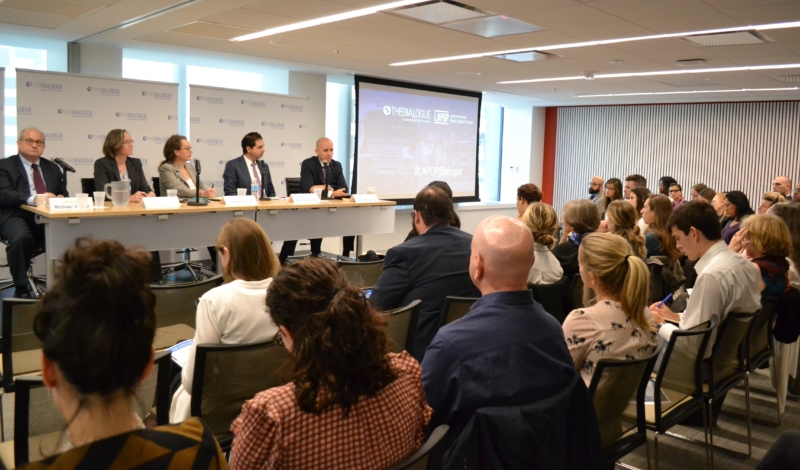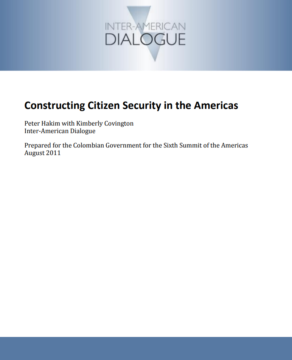A Conversation with Alonso Salazar
Medellín is Colombia’s second largest and fastest growing city, but also the most dangerous major city in the country.
On October 3, Inter-American Dialogue and the Latin American Public Opinion Project (LAPOP) hosted an event entitled “How Insecurity Shapes Daily Life in Central America” to discuss a new report on crime avoidance in Central America. The event was moderated by Michael Shifter, with speakers including Elizabeth Zechmeister (Professor of Political Science at Vanderbilt University and Director of LAPOP), Carole Wilson (Senior Data Analyst and Researcher at LAPOP), Michael Camilleri (Director of the Peter D. Bell Rule of Law Program at the Dialogue), and Juan Gonzalez (Associate Vice President of the Cohen Group and former Deputy Assistant Secretary of State for Central America and the Caribbean). The panel discussed the report’s methodology and findings, as well as some of the broader implications of the research for policymakers in Latin America and the United States.
In Northern Triangle, more than 1 in 2 fear being a victim of a homicide @Lapop_Barometro #LAPOPDialogue
— The Dialogue (@The_Dialogue) October 3, 2017
Dr. Zechmeister began by explaining the methodology of the study, providing an overview of the data collection process used by the Latin American Public Opinion Project. For this project, LAPOP conducted thousands of face-to-face interviews in various countries with a standardized procedure and careful pre-testing of survey questions in order to generate more nuanced data. Analysis of the data yielded several interesting findings, which were discussed by Dr. Wilson. She noted that in Central America, insecurity is on the rise and that crime victimization, fear of homicide, and homicide awareness have also increased. In response to growing perceptions of insecurity, individuals engage in crime avoidance behaviors -- that is, actions taken in order to minimize the risk of being the victim of a crime. Examples of crime avoidance behaviors include preventing children from playing in the street, avoiding leaving the house alone at night, avoiding public transportation, moving neighborhoods, keeping children home from school, etc. These crime avoidance behaviors were measured and used to create a Crime Avoidance Index, which maps the extent of crime-averse coping behaviors displayed by individuals on a scale from 0 to 100. This particular study found that crime avoidance was highest in the Northern Triangle countries (El Salvador, Honduras, and Guatemala).
About 1 in 3 in Northern Triangle have considered migration due to insecurity @Lapop_Barometro #LAPOPDialogue
— The Dialogue (@The_Dialogue) October 3, 2017
The conversation then turned to the issue of migration, given that one-third of individuals surveyed indicated that they had considered migrating as a result of insecurity, with intentions to migrate having increased sharply in recent years. Since crime avoidance and victimization have been shown to rival economic factors in motivating migration, examining insecurity as a “push” factor is critical for gaining a better understanding of how to go about formulating effective migration policy. On this point, Mr. Camilleri presented several recommendations based on the study’s findings. These include reframing security in economic terms, investing in community organizations and local institutions, improving police efficacy and responsiveness, and protecting citizens’ access to education and public transportation. Finally, Mr. Gonzalez discussed what steps might be taken by governments to address the issues at the intersection of insecurity and migration. He highlighted the need for long-term changes, such as increased investment in the region and better cooperation between the countries affected by these issues, as well as short-term bridging actions that bring together the public and private sector to establish common priorities.
This report by the Inter-American Dialogue and the Latin American Public Opinion Project illuminates the impact of insecurity on everyday life in Central America and spotlights the need for renewed efforts to address insecurity in the Northern Triangle moving forward.
InSight Crime: How Fear of Crime in Central America Impacts Daily Life, Contributes to Migration
Vanderbilt University: Crime casts pall on Central America’s Northern Triangle
Medellín is Colombia’s second largest and fastest growing city, but also the most dangerous major city in the country.
Violent crime in Central America, particularly in the “northern triangle,” is reaching breathtaking levels.
Public security is today the issue that most troubles the citizens of nearly every country of Latin America and the Caribbean.
 Ben Raderstorf / Inter-American Dialogue
Ben Raderstorf / Inter-American Dialogue

